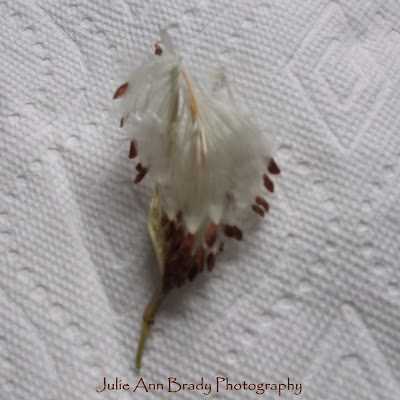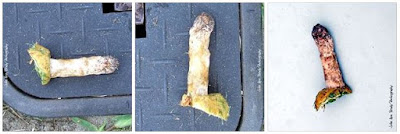Have you ever tried to harvest the teeny seeds from the seed pods of Tropical Milkweed? I have! Let me tell you that the first year I grew Tropical Milkweed in my front yard garden, I watched the seed pods open and disperse little cottony white parachutes with a teeny seed at the bottom. They'd blow everywhere and I'd find a lot accumulated on the rugs in my carport. The next year, I had a plethora of seed pods and cut off a few. And, then the Monarch caterpillars showed up and seemed to love eating the seed pods.
 |
| Monarch Caterpillars Eating Tropical Milkweed Seed Pod |
 |
| Monarch Caterpillars Eating Tropical Milkweed Seed Pod |
This year, it started off kind of funny with me harvesting the seeds from a seed pod. I had come out to my front yard garden to water plants and check the Tropical Milkweed for Monarch caterpillars. As I looked closely rather in the center of the plant, I saw what looked like an unusually flat, brown and white caterpillar!! Looking at it later in the day, I thought the same thing and what was it exactly. I started Googling and could just not find such an insect or bug. Take a look at the picture below ... what do you see??
 |
| Is that a Brown and White Caterpillar on my Tropical Milkweed? |
The next morning, I was still seeing what I thought was an unusually flat brown and white caterpillar with two antennae on the bottom as it appeared to be upside down on the Tropical Milkweed leaf. It took another morning for me to finally notice that there was white cottony stuff emerging from that area ... Oh my goodness, that is the inside of a split seed pod. I had no idea that I had caught the seed pod in an early opening where all the cottony substance and seeds were flat.
 |
| Tropical Milkweed Seed Pod Opening with Seeds |
On May 13, 2019, I started the process of harvesting seeds from the cottony substance inside Tropical Milkweed Seed Pods. In the photo above, that is the same seed pod that I thought was a brown and white caterpillar!!
 |
| Tropical Milkweed Seed Pod Opening with Seeds |
Mother Nature is quite remarkable! Look at the intricacy of the composition from the inside of the seed pod.
 |
| Tropical Milkweed Seed Pod Opening with Seeds |
I had put the seed pod to dry in my shed. Working with the seed pods, you want to be in a dry place and not outside where a wind gust can grab the cottony parachutes and put your seed in flight!!
 |
| Two Tropical Milkweed Seed Pods Opening with Seeds |
When I did my first harvesting of seeds from the seed pods, I actually had two of them!! I found it is easier to have the cottony substance release the seeds if they are dried for a while.
 |
| Two Tropical Milkweed Seed Pods Opening with Seeds |
Wow, take a look at all the seeds AND cottony substance. I kept having to wipe my hands in a paper towel as my fingers were getting really sticky and I couldn't separate the cottony substance from my fingers. It was a sticky wicket for sure!!
 |
| Two Tropical Milkweed Seed Pods and Harvested Seeds of One |
After a lot of concentrated work, I was able to separate all the tiny seeds from the cottony substance and was ready to work on the second seed pod.
 |
| Harvested Seeds from Two Tropical Milkweed Seed Pods |
Looking at the two piles of harvested seeds from the Tropical Milkweed Seed Pods, can YOU guess how many seeds there were in each pile??
TAKE A CLOSER LOOK AT THE SEEDS
 |
| Harvested Seeds from the First Tropical Milkweed Seed Pod |
 |
| Harvested Seeds from the Second Tropical Milkweed Seed Pod |
Before I started counting the seeds in each pile, I was guessing that there surely had to be about 50 or so tiny seeds in each seed pod. I was pretty close when you think about it. In the first pile, I counted some 85 ... now I think I might have been high on that count. In the second pile, I counted some 65! So, 85 plus 65 equals 150 with an average of 75. I would estimate that 70-75 seeds could be what you would expect in an average seed pod.
LET'S PLANT THOSE SEEDS!
I have bunnies in my yard like you wouldn't believe. Last night it was 8:50pm when I stepped outside to anticipate perhaps a little rain for us. I stepped to my sunflower garden area behind the shed and heard a sound from the front yard. I glanced down my golf cart path side yard to the front. A bunny hopped into view, then a second, and then a third. Bunnies!! The bunnies will eat your seedlings and munch on your flowering plants.
With anticipation of bunnies in my garden, I took poundable edging and made a rectangular planting area for the Tropical Milkweed seeds in my front yard garden.
 |
| Tropical Milkweed Seedlings Emerging on June 3, 2019 |
I started seeing little seedlings emerging fairly quickly. Looking closely at the tiny leaves, I thought, "some of those look like Vinca!" I have some pink Vincas here and there in my front yard garden and if you've ever had them, you'll notice that they can spread like you planted seeds here and there. So, I need to keep checking on the seedlings to see how many of those are indeed Tropical Milkweed.
Have you ever harvested the seeds from the seed pods of Tropical Milkweed? Who seriously knew it could be so interesting. That cottony substance is silk soft and a miracle of Mother Nature for sure!!

















